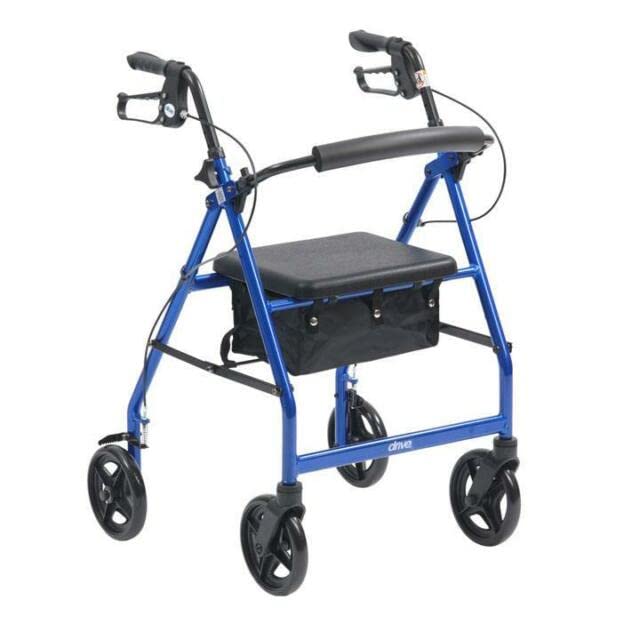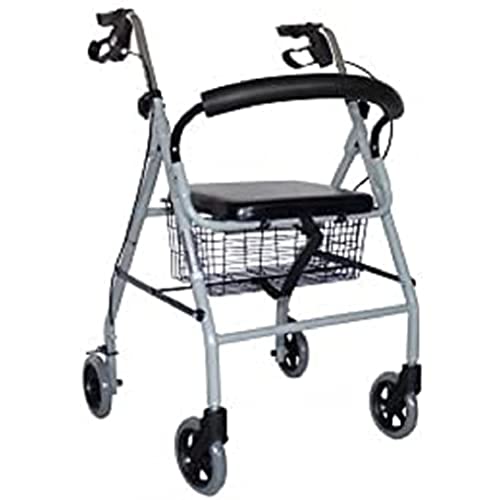See What Seated Rollator Tricks The Celebs Are Using
페이지 정보
작성자Alexandria 댓글댓글 0건 조회조회 20회 작성일 24-10-14 13:11본문
 The Convenience of a Sitting Rollator
The Convenience of a Sitting RollatorA seated rollator is lightweight and compact, making it easy to transport and store. This makes it possible for seniors to be active in their communities and engage in daily activities with a new sense of confidence and dignity.
Keeping a seated rollator in good condition is essential to ensure safety. Regular inspections of the wheels and brakes can help prevent breakdowns or accidents.
Stability
The frame of a rollator for seated use is usually made from durable materials like aluminum or steel. This guarantees stability and durability. The frame helps support the user's weight, which makes it easier for them to stand upright and maintain their balance while sitting. This is particularly important for people who have mobility limitations, since it allows them to sit down and not need to locate an area to sit or lean against something.
The most popular type of brake on a seated rollator is the cable loop brake system, which functions similarly to brakes on a bike. Users must press the handles and levers simultaneously with both hands to activate the brakes. Once the brakes are engaged they remain locked until the user is ready to release them and begin walking again. This kind of brake system is very useful for users since it allows them to easily and safely stop their rollator in any environment.
The study shows that seated rollators enhance mobility stability for young, able-bodied people when the handle height is appropriately adjusted and positioned. This includes a shorter preparation time for seat-off and improved COPfeet and sway areas during standing up and while sitting down. It also includes a more upright posture when trying to maintain the stability of a posture. The increased stability of movement is due to the additional sensorimotor input that full rollator support can provide as opposed to touch which provides spatial clues through a tactile.
To use a seated rollator, stand close to it with your back against the seat, and then grab the handles to provide support. To stop the seated rollator from moving away, make sure the brakes are locked before moving forward. Sit gently and slowly, making sure that your feet are in place under you. Once you're seated, slowly lean your body forward and hold the handles. This will allow you to shift your weight to your legs. When you're ready, release the brakes and place your body in the rear wheels of the seated rollator.
Convenience
As opposed to a regular walker a seated rollator offers an integrated seat that can provide resting support when required. This can be especially helpful when people have long periods of standing routine activities. For instance sitting in the waiting room of a doctor or the checkout lines can be a challenge for those with mobility issues. By offering the ability to sit down, a seated rollator can allow them to re-discover many opportunities for enjoyment and independence that may have been unattainable without it.
Rollators come in a variety to suit various user needs. They typically have a lightweight but sturdy frame that can help foster enhanced mobility, speed of walking, and confidence in oneself. Aluminum is commonly used to create a light frame that provides the strength needed by people with weight restrictions. These mobility aids are usually equipped with a padded seat, as well as convenient storage options.
When evaluating a seated rollator when evaluating a seated rollator, it is essential to consider the height of the handles and seat. To determine the appropriate handle height, the user should wear normal shoes, with their arms at their sides and their elbows bent slightly. This measurement will determine the size of the handle that is most comfortable and secure. You can use the same method to determine the correct height of the seat to the floor. The ideal height for a seat is the one that allows the person to sit comfortably and have their feet on the ground.
A seated rollator should include hand brakes for effortless stopping and to keep the device in control when it is not in use. They function similarly to the brakes on bicycles and are easily activated by simply pressing the levers and handles at once with both hands. Some models have slow-down brakes to provide additional security when driving downhill.
For additional convenience, a seated rollator can be outfitted with a basket to conveniently store personal items, groceries, or other essentials for shopping. These baskets are typically designed to fold up with the unit, making it easy to carry and put away when not in use. Additionally, walker trays or cup holders can be connected to the handles of a seated rollator for easy access to snacks and beverages while walking.
Safety
The safety of a seated rollator depends on the user's ability to maintain their balance and maneuver the device properly. It is also about keeping an eye of the terrain and being cautious when moving through crowded areas or on doorsteps, curbs and sidewalks. The brakes of the device need to be secured prior to sitting on the seat, and then disengaged once they are able to stand.
Adjusting the handle height to match the length of the arm can improve stability. This reduces strain and encourages a better posture. It is also important not to be being too slouching or leaning too much on the handles while walking, as it can cause fatigue quickly.
Another thing to consider is the type of brake system the device is equipped with. The majority of rollators with seats have brakes that lock. This ensures that the device doesn't accidentally move away from the place where the user is seated. The most commonly used type of brake is a cable loop system, which functions similarly to the brakes on an adult bicycle. To activate the brakes, the user has to squeeze one or both brake levers that are located on either side of their seat. This method is perfect for those who do not have the strength to operate a push-down brake or are prone to forgetting to engage brakes.
A seated rollator gives the ability to rest while out in public, without having to search or fight for a chair which can be exhausting and uncomfortable on tender joints. This feature is especially helpful in areas with a lot of people, such as parks and stadiums in which finding seats with an appropriate height can be a challenge.
The majority of rollators have a basket or pouch to store essentials such as food, medicines and personal hygiene items. Some models also have an additional compartment underneath the seat to give you more storage space. There are numerous accessories that can be purchased separately, such as cups holder and a snack tray and a bag organizer. It is important to keep in mind that any modifications made without authorization or the use of non-original accessories could create safety risks and invalidate any warranty on the device. It's recommended that the user seek advice from a manufacturer or dealer regarding any possible modifications or improvements before making them.
Customization
Rollators are available in various shapes and sizes to match the needs of users. Three-wheeled models are usually the best option for those looking for an ultra-compact and lightweight design that is easy to maneuver in tight spaces. These models are more mobile and lighter and have frames that folds down and easily tucked away in a trunk.
Rollators with four wheels provide more stability than those with three wheels. They are a great option for those with mobility issues that are more severe. Their four wheels evenly distribute weight and allow them to maneuver over different surfaces both indoors and out. These models also have seats so that passengers can sit comfortably during longer journeys.
In addition to seating and a seat, some rollators come with storage spaces to store personal items and make it easier for people to be on the move without needing to return to their car for additional items. Storage options are useful to keep everyday items close at hand. This reduces the chance of a fall when you are reaching for something from a remote location.
Users of the Rollator can also customize their device by adding features and accessories. This could include a pouch or basket for snacks, medications or other things, and helps keep them organized when on the move. Some rollators come with brake handles that are ergonomically designed to reduce pressure on the hand and allow the user to control the device easily. Others have locking mechanisms to stop or park.
 The handlebars on a rollator may also be adjusted to accommodate the height of the user. Adjustments are made quickly and easily with the use of a knob which makes it easy for anyone to set their desired height. There are also several hand-brake styles, including loop-lock brakes which require the user's hands to be placed into the hard plastic loops at the handlebars, or push-down brakes similar to bicycle brakes. Some manufacturers offer bariatric models with larger seats to accommodate larger people.
The handlebars on a rollator may also be adjusted to accommodate the height of the user. Adjustments are made quickly and easily with the use of a knob which makes it easy for anyone to set their desired height. There are also several hand-brake styles, including loop-lock brakes which require the user's hands to be placed into the hard plastic loops at the handlebars, or push-down brakes similar to bicycle brakes. Some manufacturers offer bariatric models with larger seats to accommodate larger people.댓글목록
등록된 댓글이 없습니다.

